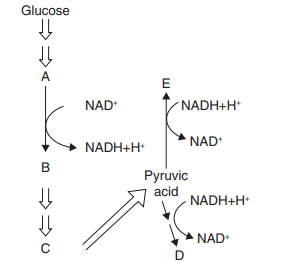1. The connecting link among glycolysis, Kreb’s cycle and beta-oxidation of fatty acid is
a) Pyruvic acid
b) Acetyl-CoA
c) Acetaldehyde
d) Citric acid
Explanation: Acetyl-CoA
2. Which of the following is the source of respiration?
a) Stored food
b) RNA
c) DNA
d) ATP
Explanation: Stored food
3. From the substrate level, how many phosphorylation ATP are produced?
a) 2
b) 6
c) 10
d) 8
Explanation: 6
4.Select the incorrect statement:
a) Plants have no special system for breathing or gaseous exchange.
b) Acetyl-CoA enter in TCA cycle running in matrix of mitochondria.
c) The RQ depends upon the type of respirarory substance used during respiration.
d) In fermentation, the complete oxidation of glucose occur in some bacteria.
Explanation: "In fermentation, the complete oxidation of glucose occur in some bacteria". This is incorrect statement.
5. The aerobic respiration yields
a) \[8NADH_{2},2FADH_{2},2ATP\]
b) \[10NADH_{2},2FADH_{2},38ATP\]
c) \[12NADH_{2},30FADH_{2},H_{2}O\]
d) \[10NADH_{2},2FADH_{2},2GTP,2ATP\]
Explanation: \[10NADH_{2},2FADH_{2},38ATP\]
6. How many ATP are used/required in glycolysis or for the complete phosphorylation of a
glucose
molecule?
a) 4
b) 2
c) 6
d) 8
Explanation: 2 ATP
7. Identify A to E in the given figure.

a) A–Phosphoenol Pyruvic acid, B–Lactic acid, C–3-Phosphoglyceric acid, D–Ethanol +
\[CO_{2}\], E–Glyceraldehyde 3-Phosphate
b) A–Glyceraldehyde 3-Phosphate, B–3-Phosphoglyceric acid, C–Phosphoenol Pyruvic
acid, D–Ethanol +\[CO_{2}\], E–Lactic acid
c) A–Lactic acid, B–Ethanol + \[CO_{2}\], C–Glyceraldehyde 3-Phosphate, D–Phosphoenol
Pyruvic acid, E–3-Phosphoglyceric acid
d) A–3-Phosphoglyceric acid, B–Phosphoenol Pyruvic acid, C–Lactic acid,
D–Glyceraldehyde 3-Phosphate, E–Ethanol + \[CO_{2}\]
Explanation: A–Glyceraldehyde 3-Phosphate, B–3-Phosphoglyceric acid, C–Phosphoenol Pyruvic acid, D–Ethanol +\[CO_{2}\], E–Lactic acid
8. Isomerization takes place in
a) Glycolysis
b) Kreb’s cycle
c) Oxidative phosphorylation
d) None of these
Explanation: Isomerization takes place in Glycolysis.
9. In cellular respiration, \[O_{2}\] is used as a final receptor of
a) ATP and NADH
b) H and e-
c) Fe
d) Cytochrome
Explanation: In cellular respiration, \[O_{2}\] is used as a final receptor of H and e-
10. The first stage in respiration is
a) Aerobic oxidation of pyruvic acid
b) Liberation of \[CO_{2}\]
c) Glycolysis
d) Electron transport system
Explanation: The first stage in respiration is Glycolysis